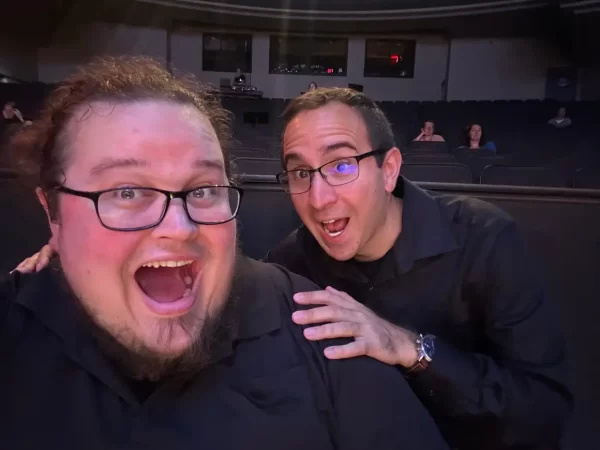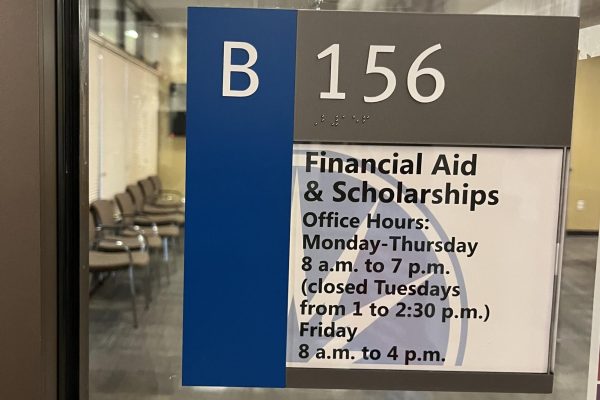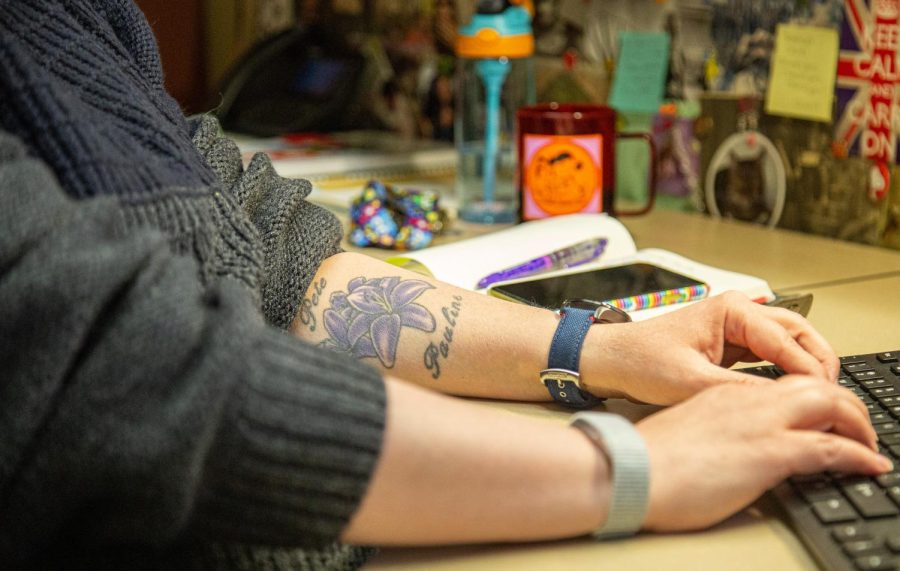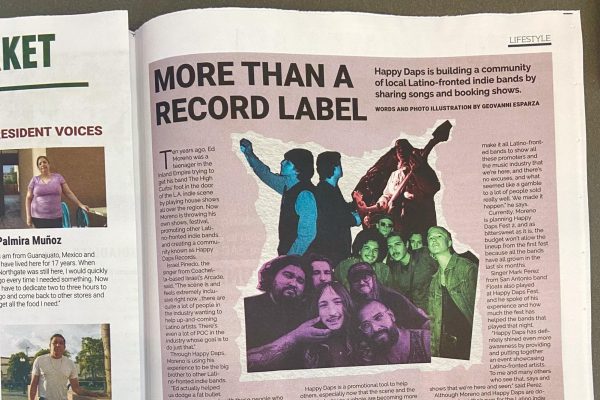“…Way of measuring a lifetime:” Examining the meaning and importance behind teacher tattoos
This story is the third in a series about campus tattoos and their significance.
March 5, 2023
When I was canvassing around the numerous lounges and public spaces of Elgin Community College with the woven strap of my camera strung around my right shoulder and my small steno notepad and pencil in hand, I had no idea what I was getting into.
What started as a seed of an idea, which simply entailed talking to students about their tattoos, would eventually blossom into discovering beautiful, heartfelt and personal stories from everyday college students about their pasts and what influenced their decision to get art permanently printed on their bodies.
I was getting the perspective of tattoos from young Gen Z students. They shed light on what tattoos as a whole means to them, whether it be from expressing themselves, permanently reminding them of something significant that occurred in their lives or just getting a design that really stuck with them or thought was cool.
What was missing from this ever-growing stream of conversation was the perspective of the millennials and Gen X, more specifically teachers.
According to an article written by the Chicago Tribune, nearly half of the millennials are tattooed, compared to 13% of baby boomers. A third of 40-somethings had tattoos in 2015, up from 14% in 2003.
Peace and Flowers
English professor Lori Clark sat down and talked about the importance of two of her tattoos. The first one she got was a peace sign on the back of her shoulder, which she got when she was around 28-years-old.
“I think I was a little bit nervous [about getting a tattoo] but I was also excited,” Clark said. “I was with some friends who were also getting tattoos, so it was more of a fun experience…”
To Clark, the tattoo symbolized the ending of a marriage and what she hoped would come out of ending that bond.
“[The peace sign] tattoo I got when my divorce was final…,” Clark said. “It was sort of meant to represent the peace that I was hoping to have after that bad relationship.”
Her second tattoo is a flower located on her inner forearm with the names of her grandparents written on top and bottom of the purple floral design.
“This tattoo is a memorial for my grandparents,” Clark said. “When my grandmother died in 2011, …my youngest sister and I decided that we wanted to get tattoos to honor [our] grandmother. …My grandmother loved flowers and we knew that [the tattoo] was going to be a flower.”
The pair of sisters ended up finding a picture of one of their grandmother’s flowers that their uncle had taken.
“We included my grandmother’s name, Pauline, and my grandfather’s name, Pete, with the tattoo as well,” Clark said. “… My youngest sister has the exact same tattoo on the back of her neck.”
As a whole, Clark sees the medium of tattooing as a way for someone to express themselves, no different from other forms of expression.
“I think that it’s important for people to know that tattoos are not necessarily an act of rebellion; they’re an act of expression,” Clark said. “… Every generation has had a way they express themselves whether it was through music or dance or whatever it happened to be, and so now for younger people- and even older people- there’s a lot more expression through tattoos, so I think it’s just a different form of expression and what people are used to.”
Lifespan
Professor of Photography Travis Linville explained the meaning behind his tattoo: a black and white design of a moth located on his inner forearm.
“I think it was pretty laid back,” Travis said. “It’s something I’d intended to do for a long time, and it mainly came down more to finding the time to carve out in a day. I’d say there was a degree of anticipation, but it’s something that I’d kind of had on my list of things I wanted to do for a while.”
The design came from a photograph that Linville made called Lifespan, which takes inspiration from Vanitas style paintings and compares the life of a moth to a tree.
“[The tattoo] is from a photograph I took and it’s a detail of a moth, and the [photograph] is a combination of different imagery,” Linville said. “It’s a combination of…this macro photo I took of a moth, and then the encyclopedic illustration of a tree ring. …It’s comparing the relatively brief life of a moth like this to the longevity of a tree.’
Linville discussed the themes behind some Vanitas paintings and dove deeper into how he sees moths in terms of photography.
“The concept behind [Vanitas paintings] was about carpe diem, like ‘seize the day,'” Linville said. “Life is fleeting, you know, [and] it was just this not-so-subtle reminder to kind of enjoy your life [and] use your life because time is passing. …The other thing was the moth, especially for photographers is something that’s always going towards the light, and light being our primary material in photography. That was something that was really important to me.”
Linville explained how he didn’t face any scrutiny for getting a tattoo but that he still kept the history of tattoo stigmatization in mind, and how he didn’t want a tattoo to interfere with his professional aspirations. Going further, he talked about the latitude of having a tattoo working in a creative field, bringing to light the different standards and expectations for workers and creators in that field.
Ishmael and Queequeg
Professor of English and advisor of Students Who Are Not Silent (SWANS) Kellen Bolt talked about the meaning and reasoning behind two of his tattoos: the first one a lightning bolt on his ribs and the second being a sunflower and coneflowers on his outer forearm, both of which he received this year.
In terms of his feelings on the day of getting his first tattoo, he said that it was a really wonderful and great experience.
“The first [tattoo] I got is a little lightning bolt on my ribs,” Bolt said. “Ribs because I always thought ribs look cool, also because it didn’t look good on my arm when they placed it. …Where I got it was a tattoo placed in Chicago called Wish Me Luck, …a black queer trans-owned business, so that’s part of the reason I did it there and I wanted my first tattoo to be from that place.”
Bolt got his second tattoo in the apartment of an artist he found on Instagram.
“I just really liked the work that they did,” Bolt said. “They didn’t have, like, a studio or anything, which [was] fine by me. That was just an interesting experience.”
Bolt’s love for the agriculture of his home state and his eventual decision to move during his adult life led to his decision of getting the tattoo on his outer forearm. He explained how he grew up in the Midwest, specifically in Kansas, and how he eventually moved to Illinois.
After spending a year in California, he was inspired to get a tattoo commemorating his home, the Midwest.
“Trees aren’t that big of a deal [in the Midwest],” Bolt said. “They’re not, like, everywhere, like they are in the Eastern United States, …but what is everywhere is prairie grasses and prairie flowers. …If you’ve ever seen, like, actual prairie grass and prairie flowers, they’re super tall and really cool. …So when I moved to California, I realized all of the plants were different because it didn’t rain in California, …so I wanted something that would make me think of Kansas and Illinois.”
Bolt said that the coneflowers represent Illinois, the sunflower represents Kansas and the prairie grass behind the various flower designs on his tattoo serves as visuals.
The novel Moby Dick, written by Herman Melville, serves as Bolt’s “weird” understanding of tattoos.
He went into great detail about the book, comparing and contrasting the universal themes behind the main characters Ishmael and Queequeg. Bolt explained that Ishmael is an American trying to overcome his white supremacy and own feelings of internalized homophobia, whereas Queequeg is a heavily tattooed character from Polynesia and represents everything else in the world, specifically the indigenous people.
Specifically, Bolt’s philosophy and idea of the art of tattoos come from the yin-and-yang of two distinctly polarizing characters.
“I was reading [Moby Dick] and it really struck me [because] Ishmael is this person in the mid-19, the mid-1800s, when tattoos are very stigmatized and when tattoos are a sign of, you know, you don’t belong, you are foreign, you are queer,” Bolt said. “He chooses to tattoo his entire body as a way of sort of dis-identifying from the racist, sexist and homophobic structures of the United States in a way that he’s actively choosing to dis-identify with them by tattooing his body.”





















